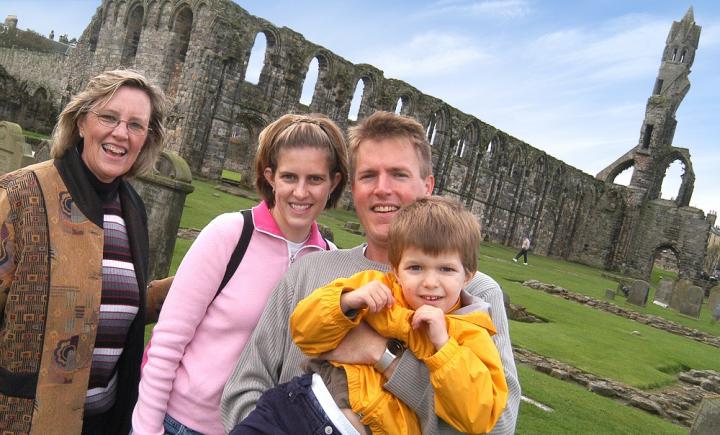Generation Scotland
Generation Scotland consists of three core studies. Read all about them and how they might help your research here.

Generation Scotland gathers responses to questionnaires of health and well-being from birth through life. We combine this with NHS health records and innovative laboratory science to understand health trajectories. We work closely with researchers and our volunteers to create a rich evidence base for understanding health. Through this rigorous, ethical and safe approach to research, we seek to enable meaningful change in public health.
Generation Scotland is proud to be funded by the Wellcome Trust. We are based at The University of Edinburgh within the Centre for Genomic and Experimental Medicine, MRC Institute of Genetics and Cancer, Centre for Medical Informatics and The Usher Institute.
Click the drop down menus to learn more about the data sets available.
The Scottish Family Health Study is an intensively phenotyped, family-based cohort for the study of the genetic basis of common complex diseases and response to treatments. Recruitment began early in 2006 and was completed in 2011. The cohort includes just over 24,000 participants, with most consenting to record linkage and recontact.
Each participant gave blood or saliva samples (for processing, biochemistry and cryopreservation) and a urine sample. The blood or saliva samples were processed to DNA and extensive genotyping was carried out on over 20,000 participants by 2015.
Data Dictionary
To help you design your study, we've made a data dictionary for the Scottish Family Health Study available.
Scottish Family Health Study Data Dictionary
Study Methodology
Please see the following links for a description of the methods used for data collection:
Clinical and Questionnaire Data
Data overview:
Pre-clinic questionnaire
- Demographic details
- Occupational history
- Lifestyle – smoking, alcohol, diet and exercise
- Personal and family medical history, age at menarche and menopause
- Rose angina questionnaire
- Musculoskeletal questions – including Chronic Pain Grade, history of fractures
- Current drug history, including prescribed and non-prescribed medications, HRT use
Physical measurements
- Height, weight, waist-hip ratio
- Blood pressure x 2 (Omron BP Monitor), resting pulse
- Ankle brachial pressure index (ABPI)
- Spirometry - FEV1, FVC, FEF
- ECG
- Bioimpedance (% body fat)
Cognitive function measurements
- Eysenck Personality Questionnaire Revised Short Form
- Logical Memory from the Wechsler Memory Scale III
- Digit Symbol from the Wechsler Adult Intelligence Scale III
- Verbal Fluency
- Mill Hill Vocabulary Scale
- General Health Questionnaire – 28
Mental health measurements
- SCID Brief screening interview for major depression
- SPQ-B Personality Questionnaire
- MDQ Mood Questionnaire
Biochemistry measures
- Urea
- Sodium
- Creatinine
- Glucose
- Potassium
- Total cholesterol
- HDL cholesterol
Questionnaires
SFHS Clinical Record Form (74.63 KB PDF)
SFHS Pre-Clinical Questionnaire - Phase 1 (144.46 KB PDF)
SFHS Pre-Clinical Questionnaire - Phase 2 (592.41 KB PDF)
Genotype
DNA from over 20,000 Scottish Family Health Study participants has been analysed by high density genome-wide chip genotyping, Illumina OmniExpress SNP GWAS (700k) and exome chip (250K), with low failure and high call rates. Quality control analyses were performed, data cleaned using quality scores and proportions typed. Sample identity was verified against recorded gender and pedigree and data checked for unknown relationships based on estimated identity-by-descent. Population stratification was assessed by analysis of principal components and imputing all data to the 1000 Genome data set.
We worked closely with collaborators on generating genetic data on its resource, in particular with the Quantitative Trait Locus (QTL) group at MRC Institute of Genetics and Cancer.
Quantitative Trait Locus (QTL) group.
Study Documentation
Genetic Health in the 21st Century is a resource of control DNA and genetic and phenotypic information. The study includes nearly 2,000 consenting individuals from 6 different locations across Scotland. It is designed to help establish the genetic profile of a control population living in Scotland in relation to health and disease. Recruitment took place in Aberdeen, Banff, Dundee, Edinburgh, Glasgow and Peterhead.Study Methodology
DNA was extracted from all blood samples and archive and working stocks prepared. Purified blood cells were stored and can be used to make lymphoblastoid cell lines.
Data Overview
21CGH Questionnaire (116.62 KB PDF)
Study Documentation
We collected human control DNA samples and plasma from blood donors attending sessions at the Scottish National Blood Transfusion Service, in more than 140 locations throughout Scotland.
Recruitment took place during 2008 and the collection contains almost 5,000 samples with accompanying data.
Study Methodology
Please see the following reference for a description of the methods used:
The purpose of of the Donor DNA Databank is to provide a long term, well characterised resource of human DNA control samples. 'Case' samples are unique to each disease study, but the same control samples can be used across many studies if appropriately collected and characterised. The Donor DNA Databank provides access to a collection of well-maintained stocks of control DNA obtained with consent from the Scottish population. Donors answered a short questionnaire and allowed a sample of their blood and a filter, which would otherwise be discarded, to be used by the project. Questionnaire data was entered into the databank using Optical Mark Read (OMR) technology. The collected data, DNA and plasma samples were unlinked and fully anonymised 28 days after collection.
Study Documentation
3D Patient Information Leaflet (83.08 KB PDF)
3D Consent Form (48.36 KB PDF)
Data Overview
3D Questionnaire (57.42 KB PDF)
- Age group, Sex
- Cultural Background
- Participant and Parental Scottish Region or Country of Origin
- Grandparental Origin (Scotland/Other)
- SNBTS donor inclusion criteria
Overview of the project, including the ethnic and geographical distribution of the cohort:
Donor DNA databank data can be accessed through the Edinburgh Datashare website.

